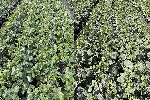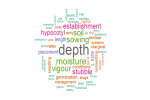Pulse profitability is the target of four GRDC investments that aim to close national pulse yield gaps, including in lentils
Investments in grain legume agronomy are helping to close yield gaps. Four GRDC projects that began in 2021 target pulse productivity in New South Wales, Victoria, South Australia and Western Australia. The projects are due for completion in 2025.
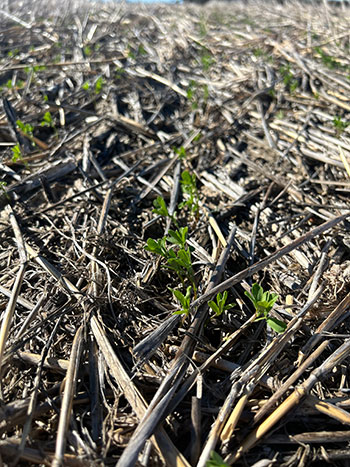 Investments in grain legume agronomy are helping to close yield gaps. Photo: SEPWA
Investments in grain legume agronomy are helping to close yield gaps. Photo: SEPWA
The primary aim is to quantify current yield gaps in grain legumes and identify best-practice legume agronomy that can improve technical efficiency by growers and advisers to lift whole-system profitability.
The projects are also designed to drive and support sustainable expansion of the area sown to grain legumes.
Activities in each region are structured in a hub-and-spoke model, with the hub serving as the research and development trial while the spokes provide the validation trials and on-farm demonstrations. This allows for in-built extension for the research and development findings.
The hubs focus on a combination of district grower-driven research priorities. They also offer extension for lessons arising from projects run with replicated trials to measure yield gaps.
Spoke sites involve simpler trials on-farm. These may include paddock-scale strip trials or small demonstration plot trials for local grower priorities.
Links between these projects facilitate a broader understanding of the main causes of the grain legume yield gap.
Common research themes are:
- economic impacts of grain legumes on farm profitability;
- disease and integrated weed management; and
- flexible responses to emerging grower issues, primarily arising from the GRDC National Growers Networks (NGN).
Western Australia
Dr Daniel Kidd of the Grower Group Alliance oversees the WA project, which started in 2022. He says WA growers know the benefits of growing a legume in their rotation but have concerns about reliability and profitability and lack confidence in legumes’ production consistency.
Due to the prevalence of sandy, acid soils in WA, lupins remain the most widely grown grain legume. However, a prolonged period of poor market prices and a contraction in the grain feed market due to lower sheep numbers have seen lupins fall from rotations in favour of higher-value canola.
Lentils are viewed as being higher risk in WA because of inconsistent production and high input costs. Also, because of the low volumes of these grains produced in the state, there are often difficulties in finding a market through the bulk handling system.
However, Dr Kidd notes that genetic improvement in grain legume varieties combined with recent advances in grain legume research – such as commercially released acid-tolerant rhizobia – has the potential to improve the consistency of production and reduce the risks.
In the west, the project is looking to increase the adoption of grain legumes by demonstrating agronomic best practice and comparing the profitability of grain legumes, in the year of production, to cereals and canola. They are also examining the potential yield benefit to the following crop.
There are 13 grower groups in the WA project, spanning a geographic range of more than 1000 kilometres from Yuna in the northern wheatbelt to Esperance on the south-east coast.
The groups are supported by experts in the WA Department of Primary Industries and Regional Development (DPIRD). Each group is hosting trials and demonstration sites that are attempting to answer some of the diverse agronomic questions posed by their local growers.
These include:
- What is the most profitable grain legume and cultivar for my climate and soil type?
- What are the most effective and economic herbicide and fungicide options?
- Does the use of new acid-tolerant rhizobia improve yields?
- Is brown manuring a cost-effective option in the low-rainfall zone?
- How responsive are grain legumes to additional phosphorus and potassium fertilisers?
- How does row spacing influence disease pressure and yield?
“Currently, lentils are only viewed as a profitable crop rotation in the Esperance Port Zone, where they are generally grown on heavy, free-draining soils with a pH greater than six,” Dr Kidd says.
Lentils are making up an increasing proportion of shipments in the port zone due to continued improvements in yield stability and the introduction of new varieties with herbicide tolerance.
The Esperance-based South East Premium Wheat Growers Association (SEPWA) ran lentil variety trials with DPIRD in 2023. These compared current commercial varieties with new cultivars and germplasm that are more imidazolinone tolerant or adapted to a broader range of soils and lower rainfall.
SEPWA R&D coordinator David Cook says: “This project has allowed us to look at new varieties to see if they have improved tolerance to soil constraints such as boron and sodicity and result in greater yields and returns.”
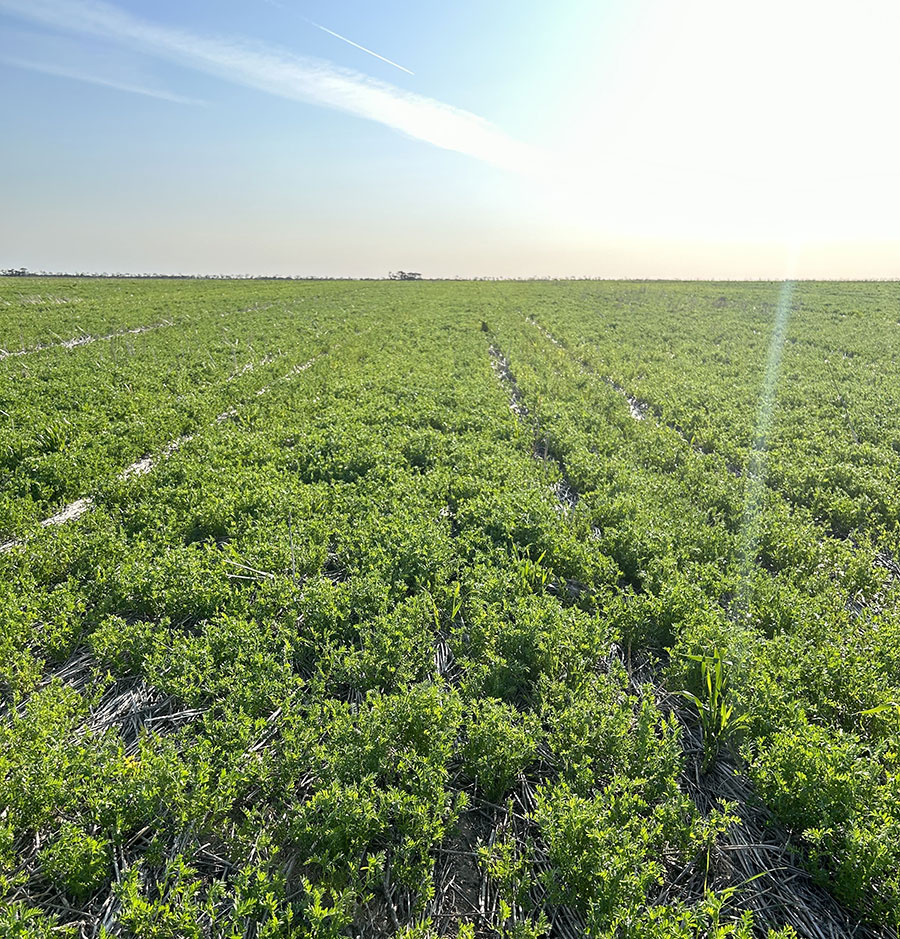
Improving the consistency of production and reducing the risk associated with some grain legume options in WA. Photo: SEPWA
Victoria
In Victoria, Dr Audrey Delahunty of Agriculture Victoria heads the regional yield gap project following the recent departure of Dr Jason Brand to Frontier Farming Systems after 24 years in the department.
Trials are examining the impacts of pulses on farm profitability, disease management and integrated weed management, plus looking at strategies and varietal response to frost.
Already, these projects have shown a role for herbicide-tolerant pulses in the farming system.
Weed management trials using herbicide-tolerant lentil varieties are demonstrating that this technology can provide opportunities to reduce, to zero, seed-set in problem weeds like vetch while maintaining grain yields.
“This is technology that requires registration of novel herbicide usages, something GRDC pursues on behalf of industry, most recently obtaining the permit PER92810 for in-crop application of metribuzin,” Dr Brand said.
Key production issues being examined include:
- new lentil varieties and yield stability across soil types and sowing dates;
- weed management, economics, risks and the fit of novel herbicide traits and new herbicides;
- differences in varietal frost tolerance in lentils and implications for grain yield;
- the yield benefit of soil amelioration practices, such as deep ripping on Mallee sands; and
- row spacing, sowing direction and stubble implications for pod drop.
The trials are also examining potential new variety releases that combine herbicide tolerances. Among the varieties tested are:
- GIA Metro – the first lentil to combine imidazolinone and metribuzin herbicide tolerance for early post-emergent application; and
- GIA Sire – the first imidazolinone-tolerant lentil with improved tolerance to clopyralid soil residues from a prior crop.
Early observations found that, in the absence of herbicides, competition from a weed such as vetch in lentils causes a reduction in grain yield of about 60 per cent.
A conventional herbicide strategy reduces yield loss from vetch competition to 23 per cent. However, strategies using the various built-in herbicide tolerance traits showed no yield loss from vetch competition.
“Use of metribuzin post-emergent in GIA Metro can provide improved control of problem weeds in lentils that potentially show increased levels of imidazolinone herbicide resistance – for example, thistles, spiny emex, radish, turnip,” Dr Brand said.
“This strategy also provides improved weed control on soil types where use of residual Group 5 products can damage crops, even at suboptimal rates. The project will look to quantify the value of the metribuzin trait to the profitability of the farming system.”
With several significant frost events occurring in 2021 and 2024 (in both vegetative and reproductive stages), varietal responses were recorded and significant variation was observed.
PBA Hurricane XT and GIA Sire showed the worst damage to vegetative frost events and GIA Thunder and PBA KelpieXT showed good tolerance. Few differences were observed among varieties after frost damage that caused flower and seed abortion.
Generally, frost events in standing stubble treatments showed less damage than mulched stubble, and row spacing and sowing direction had little effect.
The project was a collaboration between Frontier Farming Systems, Birchip Cropping Group, Southern Farming Systems and Field Applied Research (FAR) Australia.
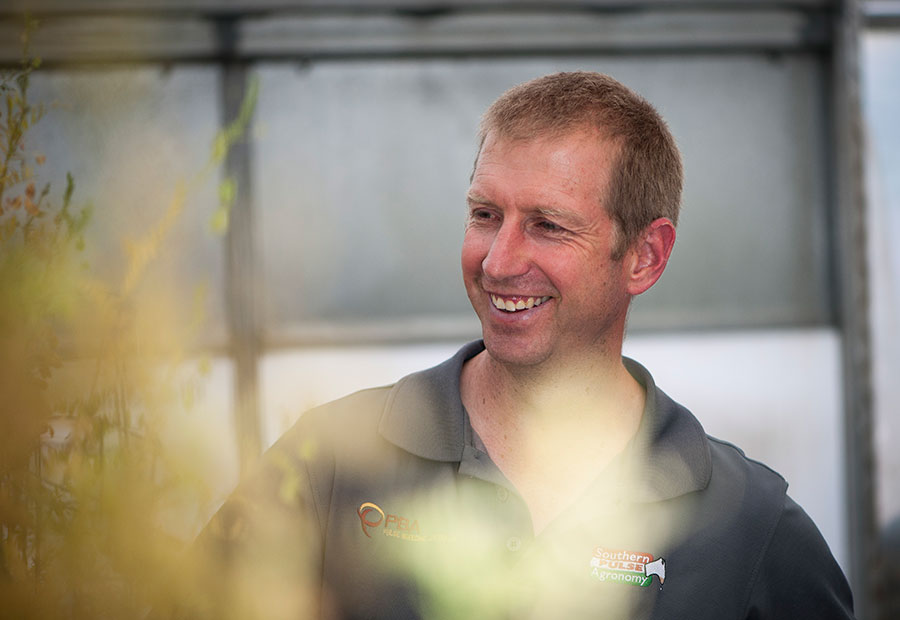
Dr Jason Brand. Photo: Brad Collis
South Australia
Sarah Day, a senior research officer at the South Australian Research and Development Institute (SARDI), is overseeing three validation hubs across SA’s subregions plus 10 on-farm spokes.
The hubs are at Tooligie, Hart and Loxton. The spoke sites are at Millicent, Melrose, Riverton, Maitland, Bute, Pinnaroo, Coomandook, Edillilie, Kimba and Wangary.
The trials are district-specific and have been designed to answer questions asked by growers at that local level. The focus is on grower-driven research priorities, which have the following scope:
- economic impacts of grain legumes on farm profitability;
- disease management and integrated weed control strategies;
- soil amelioration impacts, including from deep ripping;
- reducing pod loss;
- lentil variety trials to increase understanding of how these cultivars are adapted to expanding cropping areas; and
- flexible responses to emerging grower issues primarily arising for the GRDC NGN.
Ms Day says the goal is to address the 40 per cent yield gap between average grain legume yields and water-limited yield potential. She says the project is delivering high-calibre research supported by a district-level extension program for best-practice agronomy.
The program prioritises engagement with growers and includes field days, crop walks and ‘sticky beak’ days. More than 500 people a year have attended these activities.
Monitoring and evaluation focus groups are helping to uncover growers’ views about the adoption of pulses, the influence of peers, their perceptions around implementing pulse growing and their perceptions of pulse profitability and risk.
Key collaborators for the SA project are SARDI, Frontier Farming Systems, EPAG Research, FAR Australia and Trengove Consulting.
New South Wales
In NSW, the project is headed by Rohan Brill of Brill Ag, who oversees two hubs and five spokes in central and southern NSW. Sites were selected for local relevance with regards to challenges that might restrict the inclusion of pulses in a rotation.
This includes:
- surface acidity;
- subsoil sodicity;
- low or variable rainfall;
- waterlogging at Caragabal, Ganmain and Parkes; and
- calcareous subsoil.
In addition to quantifying the yield gap and understanding how it can be reduced, this regional activity is also exploring how additional value is provided via nitrogen fixation to boost the yields of subsequent crops.
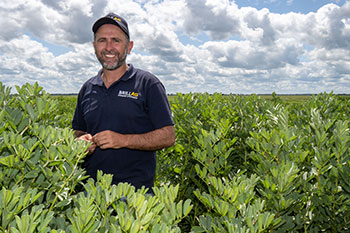 Rohan Brill of Brill Ag. Photo: Nicole Baxter
Rohan Brill of Brill Ag. Photo: Nicole Baxter
“An important part of understanding the yield gap is matching soils or soil amendments to particular pulses and effectively managing weeds and diseases,” Mr Brill says. “Consequently, trials target districts with specific soil challenges – such as sodicity and acidity – and locations where previous research has been limited.”
Interim results have shown the importance of selecting the right species for the environment. Unlike Victoria and SA, where lentils were the stand-out pulse crop, in southern and central NSW the stand-out pulse has been faba beans for both yield and net soil nitrogen contribution.
Total nitrogen fixation of all pulses was measured in 2021 and 2022 using the 15N natural abundance technique and ranged from 88 to 594 kilograms/ha with an average of 271kg/ha.
Nitrogen fixation was primarily driven by biomass production, with 33kg of nitrogen/ha fixed per tonne of above-ground biomass.
The project will calculate a nitrogen balance of each pulse species at each site. This will consider how much nitrogen is derived from fixation and how much is exported in grain, to better understand the net nitrogen benefit for each species and their agronomic management options.
An early observed trend shows lentils and chickpeas producing lower nitrogen fixation than other species. However, both these pulse crops had a positive nitrogen balance and potentially higher value grains. Lentils on average are producing a nitrogen balance of 43kg/ha.
Mr Brill is encouraging peer-to-peer learning: “Monitoring and evaluation to benchmark grower behaviour change and adoption is a key component of this investment,” Mr Brill says. “This will include measures such as area sown to grain legumes, crop mix and rotation, and economic yield gaps.”
The research will assist growers to chase high-value markets with species such as lentils in the western subregions and chickpeas in the more northern subregions of NSW.
Project collaborators include Frontier Farming, Grain Orana Alliance, FAR Australia and AgGrow Agronomy.
More information: Rohan Brill, rohan@brillag.com.au; Sarah Day, sarah.day@sa.gov.au; Jason Brand, jason@frontierfarming.com.au; Daniel Kidd, daniel.kidd@gga.org.au
Resources: GRDC Update Paper – Opportunities to improve the productivity and reliability of pulse crops grown on sandy soils in the SA Mallee; GroundCoverTM Supplement story Fit-for-purpose research targets pulse profitability.
Reversing waterlogging's yield impact
Waterlogging is a key reason that lentil yield performance is low and unstable in high-rainfall zones. In 2021, it was estimated that waterlogging can affect up to 60 per cent of Western Australian and 40 per cent of Victorian lentil crops, as well as vast tracts of South Australia.
Given the importance of this abiotic stress, a now-completed GRDC investment took the first steps towards identifying waterlogging-tolerant lentil genetics.
The project was led by South Australian Research and Development Institute (SARDI) crop ecophysiologists Dr Lachlan Lake and Professor Victor Sadras in close collaboration with Agriculture Victoria research scientists Dr Arun Shunmugam and Dr Garry Rosewarne, who work within Australia’s lentil breeding program.
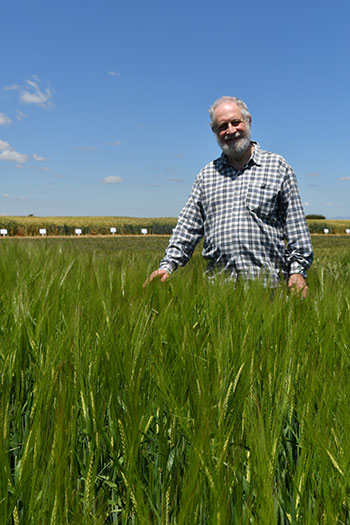 Crop ecophysiologist Professor Victor Sadras. Photo: Melissa Marino
Crop ecophysiologist Professor Victor Sadras. Photo: Melissa Marino
Following screening trials with 111 lentil lines over two years, a selectable plant trait associated with waterlogging tolerance was identified. This trait relates to plant growth rate during and after waterlogging periods.
Genetic diversity was identified for this trait and its selection in pre-breeding programs could lead to lentil cultivars with improved tolerance to hypoxic (oxygen-deficient) conditions.
The trials also profiled the waterlogging sensitivity of commercial lentil varieties, with the ratings available to inform cultivar selection.
The project identified a decoupling of the link between growth and yield due to waterlogging in 20 lentil lines in high-rainfall environments with longer growing seasons.
The decoupling resulted in excessive vegetative growth, reduced pod and seed-set and low harvest index (yield to biomass ratio). In turn, this further increased the risk of yield losses due to diseases and lodging.
The findings suggest that selection for harvest index could improve yield in all growing conditions, whereas selection for growth rate could improve yield in stressful, low-yielding growing conditions.
Trials also identified that the link between lentil growth and yield creates opportunities to exploit agronomic management practices to increase yield.
This includes the ability to sow at lower seeding rates and wider row spacing in favourable conditions.
This allows for growers to spray for disease, particularly Botrytis grey mould, later in the season and for the crop to intercept more sunlight lower in the canopy.
More information: Lachlan Lake, lachlan.lake@sa.gov.au































